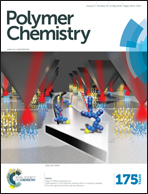Promotion of morphology transition of di-block copolymer nano-objects via RAFT dispersion copolymerization†
Abstract
Reversible addition–fragmentation chain transfer (RAFT) dispersion copolymerization of styrene (St) and methyl methacrylate (MMA) is conducted in methanol using poly(2-hydroxyethyl acrylate) (PHEA) as a macro chain transfer agent (macro-CTA). Compared with the general macro-CTA mediated alcoholic dispersion polymerization of St, RAFT dispersion copolymerization of St and MMA can promote the morphology transition of di-block copolymer nano-objects. Three phase diagrams are constructed by changing the molar ratio of St/MMA to reflect the relationship between the degree of polymerization (DP) of P(St-co-MMA), solids concentration and morphology of obtained nano-materials, and it is found that the phase diagrams could be affected by the molar ratio of St/MMA. Ultra-sensitive differential scanning calorimetry (US-DSC) is employed to determine the glass transition temperature (Tg) of polymeric nano-objects in methanol, and the result shows that the Tg values decrease with the increase of the molar content of MMA units in copolymers. Introduction of MMA units into the solvophobic block can enhance its mobility in methanol, which is beneficial for the morphology transition of di-block copolymer nano-objects.


 Please wait while we load your content...
Please wait while we load your content...